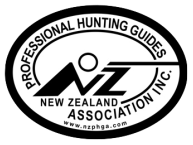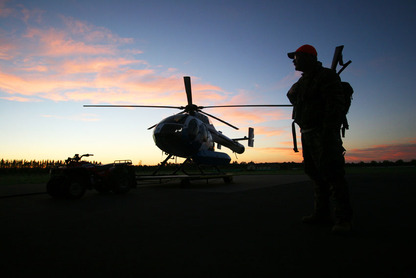.
GUIDING IN NEW ZEALAND.BACKGROUND
New Zealand has a proud recreational hunting tradition that originates from the first wild game animal populations established shortly after the European settlers arrived. A combination of a temperate climate, no natural predators, plentiful food and minimal competition has allowed many game species to thrive in New Zealand’s natural environment and consequently, some of the world's finest trophy species are found here. These species, combined with a pristine environment, exceptional terrain, a safe travel destination and welcoming attitude means New Zealand has been seen as a hunter’s paradise for generations. The NZPHGA seeks to preserve this status through sound guiding practice for both visitors and future generations of New Zealanders. GUIDED HUNTING INDUSTRY IN NEW ZEALAND It is important to note that the New Zealand guiding industry is unregulated, in that there is no statutory government body that sets industry standards or qualifications. The NZPHGA was set up as a self-regulating industry body in order to protect stakeholders within New Zealand's guided hunting industry in the event of an incident or change of legislation that could threaten the livelihoods of those who make a living from guided hunting. In the absence of a regulatory authority, the NZPHGA has developed its own set of standards and industry training that guide members must meet in order to be accepted as a member of the association. As a result, the NZPHGA holds powers of censure over its members and can hold them to account if required, which gives the hunter reassurance they will get a quality experience. Guides to who choose to remain outside the NZPHGA or fail to meet the criteria are effectively 'on their own' and remain unverified in terms of any standard they claim to meet. Clients who choose to hunt with them do so at their own risk. WHY JOIN THE NZPHGA? Being a guide member of the NZPHGA has a number of advantages for those wishing to become professional guides. 1. PROFESSIONAL HUNTER ACADEMY (PHA). New members are required to attend the PHA, an intensive seven-day training course that covers all aspects of professional guiding. For a full-breakdown of what the course covers, click here. 2. NZPHGA DOC CONCESSION. Members are automatically covered under the blanket concession which allows them to guide their clients on Department of Conservation land deemed eligible for guided hunting activity. 3. INDUSTRY SUPPORT & DEVELOPMENT. Members will have access to training, advice and development opportunities in addition to support from the NZPHGA in the event of an incident or dispute. 4. EMPLOYMENT OPPORTUNITIES. New Zealand's leading outfitters and game estates employ NZPHGA guides and the likelihood of gaining an opportunity with one of them will be greatly enhanced by NZPHGA membership. 5. ADVOCACY. The NZPHGA is a member of the Tourism Industry Association of New Zealand (TIANZ) and works closely with a number of allied organisations, giving New Zealand guided hunting representation through advocacy at the highest levels of government and industry. HUNTING ENVIRONMENTS IN NEW ZEALAND Recreational hunting in New Zealand takes place in a number of environments, in accordance with a range of definitions. It is important to understand what each of these mean when deciding the sort of guided hunt you want to offer your clients. Free Range ‘Free-Range’ means the animal is born and raised in the wild from a wild population and is hunted in a wild area of public or private land with no barriers to roam, natural or man-made, to prevent evasion of a potential hunter. Liberated or selectively-bred animals do not qualify as free-range game. Free-range land can either be public or privately-owned. (Note: under New Zealand law it is illegal to liberate game animals onto public conservation land). Game Estate ‘Game Estate’ is the term given to an enclosed area of private land with natural or man-made barriers (generally accepted as species-specific fencing), that serves the purpose of containing game animals and preventing other animals from entering and is operated for the primary purpose of hunting. To qualify as a game estate, properties must meet industry agreed standards as set out by the New Zealand Association of Game Estates (NZAGE). These standards cover fencing, disease surveillance, animal welfare, client safety, minimum area, environment, and other parameters. Hunting Block 'Hunting block' refers to areas of private land that operate wholly or in part for the purposes of hunting but do not meet, or have not been assessed against, the standards set out by the NZAGE. Fair Chase ‘Fair Chase’ is the term given to a hunt that takes place on public or private land, either free-range or game estate, where the hunted species can expess natural behaviours and has a reasonable and realistic chance of evading the hunter. A fair chase hunt depends on a number of factors including cover, area, terrain, the species sought, animal domesticity and hunter ability. The NZPHGA supports definitions of Fair Chase from internationally reputable hunting organisations: Safari Club International (SCI) ‘Fair chase is defined as pursuit of a free roaming animal or enclosed roaming animal possessed of the natural behavioural inclination to escape from the hunter and be fully free to do so.’ Boone & Crockett Club ‘Fair chase is the ethical, sportsmanlike and lawful pursuit and taking of free ranging wild game animals in a manner that does not give the hunter an improper or unfair advantage over such animals.’ Feral Range Feral Range is a term adopted by the NZ Department of Conservation and refers to the geographical area in which a given game animal species is free to roam in a wild capacity. Outside the boundaries of the feral range, measures may be taken to eradicate the species to prevent further spread into new habitats. Currently, all hunting of animals, whether in a game estate or free-range, must be conducted within that species’ feral range. Aerially-Assisted Trophy Hunting Aerially-assisted trophy hunting (AATH) is the practice of utilising helicopters to transport hunters to difficult terrain on public land for the purposes of hunting alpine animals (usually tahr or chamois). NZPHGA Code of Practice on AATH prohibits the hazing of the animal or shooting from the helicopter. AATH is currently (2014) under review by the Minister of Conservation. GAME ANIMALS IN NEW ZEALAND New Zealand has a number of game species available to the visiting or local hunter. Some are widespread whereas others are found in localised areas, as determined by feral range and habitat. Some species are found nationwide in estates but may have a localised wild population. It is important to note where the species are found in relation to where you plan to guide hunters.
In addition, New Zealand has a number of small game species, game birds, freshwater fish and saltwater fish available to complement your big game hunts. Many are subject to seasons and these need to be considered in what you offer as a guide.
|


